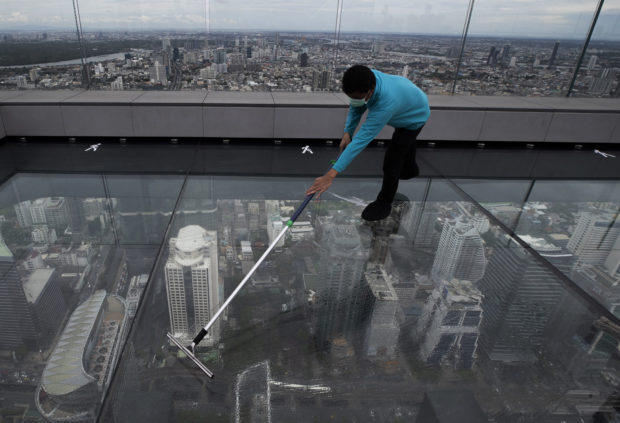
An employee wearing a face mask to help curb the spread of the coronavirus cleans the glass floor of the Mahanakhon SkyWalk, Thailand’s highest rooftop and observation deck, located on the 78th floor of King Power Mahanakhon building in Bangkok, Thailand, Tuesday, June 16, 2020. Thailand’s Cabinet has approved three projects with a combined budget of more than 22 billion baht ($707 million) to help the country’s reeling tourism industry recover from the coronavirus crisis. (AP Photo/Sakchai Lalit)
BANGKOK — Thailand’s Cabinet on Tuesday approved three projects with a combined budget of more than 22 billion baht ($707 million) to help the country’s reeling tourism industry recover from the coronavirus crisis.
The packages are meant to promote domestic travel from July to October. Tourism normally accounts for more than 10% of Thailand’s GDP. International flight arrivals were stopped in early April, drying up the market for foreign tourists.
The biggest package, with an estimated cost of 18 billion baht ($579 million), will give travelers a 40% discount to a maximum value of 3,000 baht ($96) per night for up to five nights’ accommodation. They will also be given credits of 600 baht ($19) per day, paid into the government’s existing e-wallet system, for spending on extras such as food and souvenirs.
A second package with an estimated cost of 2 billion baht ($64 million) will give up to 2 million Thais 1,000-baht ($32) subsidies for travel by air, regional buses, and car rentals.
A 2.4 billion baht ($77 million) third package does double duty by serving as a reward to about 1.2 million medical workers and other frontline fighters against COVID-19. They will be eligible for credits of 2,000 baht ($64) apiece for travel booked through local tour agencies
Plans for the gradual return of foreign travelers are under discussion. The introduction of a “travel bubble” would allow entry to a limited number of visitors vetted both by Thailand and their home countries. They would initially come from countries judged to have successfully tamed the coronavirus threat, such as China and New Zealand, and could possibly comprise business travelers and medical tourists.
However, the recent discovery of a new cluster of COVID-19 cases at a large market in the Chinese capital Beijing has become a cause for concern.